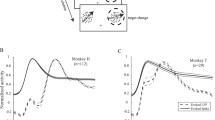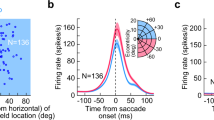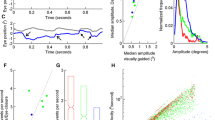Abstract
The purpose of this study was to investigate the temporal relationship between presaccadic neuronal discharges in the frontal eye fields (FEF) and supplementary eye fields (SEF) and the initiation of saccadic eye movements in macaque. We utilized an analytical technique that could reliably identify periods of neuronal modulation in individual spike trains. By comparing the observed activity of neurons with the random Poisson distribution generated from the mean discharge rate during the trial period, the period during which neural activity was significantly elevated with a predetermined confidence level was identified in each spike train. In certain neurons, bursts of action potentials were identified by determining the period in each spike train in which the activation deviated most from the expected Poisson distribution. Using this method, we related these defined periods of modulation to saccade initiation in specific cell types recorded in FEF and SEF. Cells were recorded in SEF while monkeys made saccades to targets presented alone. Cells were recorded in FEF while monkeys made saccades to targets presented alone or with surrounding distractors. There were no significant differences in the time-course of activity of the population of FEF presaccadic movement cells prior to saccades generated to singly presented or distractor-embedded targets. The discharge of presaccadic movement cells in FEF and SEF could be subdivided quantitatively into an early prelude followed by a high-rate burst of activity that occurred at a consistent interval before saccade initiation. The time of burst onset relative to saccade onset in SEF presaccadic movement cells was earlier and more variable than in FEF presaccadic movement cells. The termination of activity of another population of SEF neurons, known as preparatory set cells, was time-locked to saccade initiation. In addition, the cessation of SEF preparatory set cell activity coincided precisely with the beginning of the burst of SEF presaccadic movement cells. This finding raises the possibility that SEF preparatory set cells may be involved in saccade initiation by regulating the activation of SEF presaccadic movement cells. These results demonstrate the utility of the Poisson spike train analysis to relate periods of neuronal modulation to behavior.
Similar content being viewed by others
References
Bishop PO, Levick WR, Williams WO (1964) Statistical analysis of the dark discharge of lateral geniculate neurons. J Physiol (Lond) 170: 598–612
Bruce CJ, Goldberg ME (1985) Primate frontal eye fields. I. Single neurons discharging before saccades. J Neurophysiol 53: 603–635
Bruce CJ, Goldberg ME, Bushnell C, Stanton GB (1985) Primate frontal eye fields. II. Physiological and anatomical correlates of electrically evoked eye movements. J Neurophysiol 54: 714–734
Carpenter RHS (1981) Oculomotor procrastination. In: Fisher DF, Monty RA, Senders JW (eds) Eye movements: cognition and visual perception. Erlbaum, Hillsdale, N. J., pp 237–246
Cocatre-Zilgien JH, Delcomyn F (1992) Identification of bursts in spike trains. J Neurosci Meth 41: 19–30
Commenges D, Seal J (1985) The analysis of neuronal discharge sequences: change-point estimation and comparison of variances. Stat Med 4: 91–104
Esguerra M, Sur M (1993) Spike trains and signaling modes of neurons in the ferret lateral geniculate nucleus. Exp Brain Res 96: 273–286
Falzett M, Moore RK, Petry HM, Powers MK (1985) A method for determining threshold from single-unit activity. Brain Res 347: 127–131
Glimcher PW, Sparks DL (1992) Movement selection in advance of action in the superior colliculus. Nature 355: 542–545
Gould JH, Cusick CG, Pons TP, Kaas JH (1986) The relationship of corpus callosum connections to electrical stimulation maps of motor, supplementary motor, and frontal eye fields in owl monkeys. J Comp Neurol 247: 297–325
Hanes DP, Schall JD (1993) Relation of presaccadic discharge in frontal and supplementary eye fields to saccade initiation. Soc Neurosci Abstr 19: 426
Henn V, Cohen B (1976) Coding of information about rapid eye movements in the pontine reticular formation in alert monkeys. Brain Res 108: 307–325
Huerta MF, Kaas JH (1990) Supplementary eye field as defined by intracortical microstimulation: connections in macaque. J Comp Neurol 293: 299–330
Huerta MF, Krubitzer LA, Kaas JH (1986) Frontal eye field as defined by intracortical microstimulation in squirrel monkeys, owl monkeys and macaque monkeys: I. Subcortical connections. J Comp Neurol 253: 415–439
Judge SJ, Richmond BJ, Chu FC (1980) Implantation of magnetic search coil for measurement of eye position: an improved method. Vision Res 20: 535–538
Keller EL (1974) Participation of medial pontine reticular formation in eye movement generation in monkeys. J Neurophysiol 37: 316–332
Kirk RE (1982) Experimental design, 2nd edn. Brooks/Cole, Pacific Grove Calif.
Kuffler SW, FitzHugh R, Barlow HB (1957) Maintained activity in the cat's retina in light and darkness. J Gen Physiol 40: 683–702
Legéndy CR, Salcman M (1985) Bursts and recurrences of bursts in the spike trains of spontaneously active striate cortex neurons. J Neurophysiol 53: 926–939
Levick WR, Zacks JL (1970) Responses of cat retinal ganglion cells to brief flashes of light. J Neurophysiol 206: 677–700
Mann SE, Thau R, Schiller PH (1988) Conditional task-related responses in monkey dorsomedial frontal cortex. Exp Brain Res 69: 460–468
Maunsell JHR, Gibson JR (1992) Visual response latencies in striate cortex of the macaque monkey. J Neurophysiol 68: 1332–1344
McCormick DA, Feeser HR (1990) Functional implications of burst firing and single spike activity in lateral geniculate relay neurons. Neuroscience 39: 103–113
Moore GP, Perkel DH, Segundo JP (1967) Statistical analysis and functional interpretation of neuronal spike data. Annu Rev Physiol 28: 493–522
Oram MW, Perrett DI (1992) Time course of neural responses discriminating different views of face and head. J Neurophysiol 68: 70–84
Perkel DH, Gerstein GL, Moore GP (1967) Neuronal spike trains and stochastic point processes. Biophys J 7: 391–418
Raybourn MS, Keller EL (1977) Colliculoreticular organization in primate oculomotor system. J Neurophysiol 40: 861–878
Richmond BJ, Optican LM, Podell M, Spitzer H (1987) Temporal encoding of two-dimensional patterns by single units in primate inferior temporal cortex. I. Response characteristics. J Neurophysiol 57: 132–146
Robinson DA (1963) A method of measuring eye movement using a scleral search coil in a magnetic field. IEEE Trans Biomed Electron 10: 137–145
Robinson DA, Fuchs AF (1969) Eye movements evoked by stimulation of frontal eye fields. J Neurophysiol 32: 637–648
Rodieck RW, Kiang NYS, Gerstein GL (1962) Some quantitative methods for the study of spontaneous activity of single neurons. Biophysics J 2: 351–368
Russo GS, Bruce CJ (1993) Effect of eye position within the orbit on electrically elicited saccadic eye movements: a comparison of the macaque monkey's frontal and supplementary eye fields. J Neurophysiol 69: 800–818
Schall JD (1991a) Neuronal activity related to visually guided saccadic eye movements in the supplementary motor area of rhesus monkeys. J Neurophysiol 66: 530–558
Schall JD (1991b) Neuronal activity related to visually guided saccades in the frontal eye field of rhesus monkeys: comparison with supplementary eye fields. J Neurophysiol 66: 559–579
Schall JD, Hanes DP (1993) Neural basis of saccade target selection in frontal eye field during visual search. Nature 366: 467–469
Schall JD, Morel A, Kaas JH (1993) Topography of supplementary eye field afferents to frontal eye field in macaque: implications for mapping between saccade coordinate systems. Visual Neurosci 10: 385–393
Schlag J, Schlag-Rey M (1987) Evidence for a supplementary eye field. J Neurophysiol 57: 179–200
Seal J, Commenges D, Salamon R, Bioulac B (1983) A statistical method for the estimation of neuronal response latency and its functional interpretation. Brain Res 278: 382–386
Segraves MA (1992) Activity of monkey frontal eye field neurons projecting to oculomotor regions of the pons. J Neurophysiol 68: 1967–1985
Segraves MA, Goldberg ME (1987) Functional properties of corticotectal neurons in the monkey's frontal eye field. J Neurophysiol 58: 1387–1419
Segraves MA, Park K (1993) The relationship of monkey frontal eye field activity to saccade dynamics. J Neurophysiol 69: 1880–1889
Shook BL, Schlag-Rey M, Schlag J (1990) Primate supplementary eye field. I. Comparative aspects of mesencephalic and pontine connections. J Comp Neurol 301: 618–642
Siegel S, Castellan NJ Jr. (1988) Nonparametric statistics, 2nd edn. McGraw-Hill, New York
Smith DR, Smith GK (1965) A statistical analysis of the continual activity of single cortical neurones of the cat unanesthetized isolated forebrain. Biophys J 5: 47–74
Sparks DL (1978) Functional properties of neurons in the monkey superior colliculus: coupling of neuronal activity and saccade onset. Brain Res 156: 1–16
Sparks DL, Mays LE (1980) Movement fields of saccade related burst neurons in the monkey superior colliculus. Brain Res 190: 39–50
Stanton GB, Goldberg ME, Bruce CJ (1988) Frontal eye field efferents in the macaque monkey. II. Topography of terminal fields in midbrain and pons. J Comp Neurol 271: 493–506
Tehovnik EJ, Lee K-M (1993) The dorsomedial frontal cortex of rhesus monkey. Topographic representation of saccades evoked by electrical stimulation. Exp Brain Res 96: 430–442
Teller DY (1984) Linking propositions. Vision Res 24: 1233–1246
Thompson KG, Hanes DP, Tu FF, Schall JD (1993) Evolution of saccade target selection in frontal eye field during visual search. Soc Neurosci Abstr 19: 27
Waitzman DM, Ma TP, Optican LM, Wurtz RH (1988) Superior colliculus neurons provide the saccadic motor error signal. Exp Brain Res 72: 649–652
Wang Z, McCormick DA (1993) Control of firing mode of corticotectal and corticopontine layer V burst-generating neurons by norepinepherine, acetylcholine, and 1S,3R-ACPD. J Neurosci 13: 2199–2216
Weiss TF (1964) A model for firing patterns of auditory nerve fibers. Tech Rept Mass Inst Technol Res Lab Electron, No. 418. Mit. Boston Mass.
Wurtz RH, Goldberg ME (1972) Activity of superior colliculus in behaving monkey. III. Cells discharging before eye movements. J Neurophysiol 35: 575–586
Author information
Authors and Affiliations
Rights and permissions
About this article
Cite this article
Hanes, D.P., Thompson, K.G. & Schall, J.D. Relationship of presaccadic activity in frontal eye field and supplementary eye field to saccade initiation in macaque: Poisson spike train analysis. Exp Brain Res 103, 85–96 (1995). https://doi.org/10.1007/BF00241967
Received:
Accepted:
Issue Date:
DOI: https://doi.org/10.1007/BF00241967




